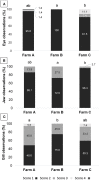Tilapia On-Farm Welfare Assessment Protocol for Semi-intensive Production Systems
- PMID: 33324705
- PMCID: PMC7723968
- DOI: 10.3389/fvets.2020.606388
Tilapia On-Farm Welfare Assessment Protocol for Semi-intensive Production Systems
Abstract
The aim of this study was to develop and test a tilapia on-farm welfare assessment protocol, based on Brazilian semi-intensive production systems. The study included two mains steps: the elaboration of tilapia welfare protocol and its on-field feasibility test. The protocol, including the potential indicators organized into health, environmental, nutritional, and behavioral categories, was tested on three farms. Skin, eyes, gills, jaws, fins, and vertebral spine were individually examined in 139 individual tilapias. Water physicochemical parameters and production system were considered. The overall nutritional status of individuals was assessed through body condition factor, feed conversion ratio, feed crude protein ratio, and feed ingestion behavior. During massive capture, signals of stress, level of crowding, and duration of air exposure were registered. Time required for loss of consciousness was evaluated by clinical reflexes and other behaviors during slaughter. Eye, jaw, and gill scores were different across farms (Kruskal-Wallis test, p = 0.011; 0.015; 0.043, respectively), showing good discrimination power. Critical welfare points were extremely low dissolved oxygen in water, fin and skin lesions, prolonged air exposure during pre-slaughter handling and non-humane slaughter techniques, as decapitation or asphyxia. The protocol presents practical viability and it is an initial step for the development of a tilapia welfare strategy, where the prioritization of critical welfare points, implementation of corrective actions and monitoring of the results is part of a permanent welfare management system.
Keywords: behavior; capture; fish; health; management; slaughter.
Copyright © 2020 Pedrazzani, Quintiliano, Bolfe, Sans and Molento.
Figures


References
-
- Chandroo KP, Duncan IJH, Moccia RD. Can fish suffer?: Perspectives on sentience, pain, fear and stress. Appl Anim Behav Sci. (2004) 86:225–50. 10.1016/j.applanim.2004.02.004 - DOI
-
- Braithwaite V. Do Fish Feel Pain? Oxford: Oxford University Press; (2010). p. 208.
-
- Sneddon LY, Lopez-Luna J, Wolfenden DCC, Leach MC, Valentim AM, Steenbergen PJ, et al. Fish sentience denial: muddying the waters. Anim Sentience. (2018) 115:1–12.
-
- Branson EJ. Fish Welfare. Oxford: Blackwell Publishing; (2008). p. 312.
LinkOut - more resources
Full Text Sources

